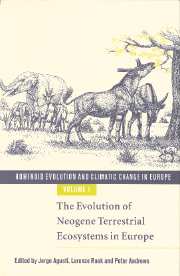Book contents
- Frontmatter
- Contents
- List of contributors
- Acknowledgements: The European Science Foundation
- 1 Introduction
- PART I Palaeogeography of the circum-Mediterranean region
- PART II Miocene mammalian successions
- PART III Palaeoenvironments: non-mammalian evidence
- PART IV Palaeoenvironments: mammalian evidence
- 19 Shrews (Mammalia, Insectivora, Soricidae) as paleoclimatic indicators in the European Neogene
- 20 Mammal turnover and global climate change in the late Miocene terrestrial record of the Vallès-Penedès Basin (NE Spain)
- 21 Palaeoenvironments of late Miocene primate localities in Macedonia, Greece
- 22 The paleoecology of the Pikermian Biome and the savanna myth
- 23 Vicariance biogeography and paleoecology of Eurasian Miocene hominoid primates
- Index
22 - The paleoecology of the Pikermian Biome and the savanna myth
from PART IV - Palaeoenvironments: mammalian evidence
Published online by Cambridge University Press: 15 December 2009
- Frontmatter
- Contents
- List of contributors
- Acknowledgements: The European Science Foundation
- 1 Introduction
- PART I Palaeogeography of the circum-Mediterranean region
- PART II Miocene mammalian successions
- PART III Palaeoenvironments: non-mammalian evidence
- PART IV Palaeoenvironments: mammalian evidence
- 19 Shrews (Mammalia, Insectivora, Soricidae) as paleoclimatic indicators in the European Neogene
- 20 Mammal turnover and global climate change in the late Miocene terrestrial record of the Vallès-Penedès Basin (NE Spain)
- 21 Palaeoenvironments of late Miocene primate localities in Macedonia, Greece
- 22 The paleoecology of the Pikermian Biome and the savanna myth
- 23 Vicariance biogeography and paleoecology of Eurasian Miocene hominoid primates
- Index
Summary
Introduction
Many important Eurasian later Miocene localities are characterized by an abundance of species of aardvarks, hyenas, hyraxes, mastodons, hipparions, rhinoceroses, giraffes, and antelopes (Kurtén, 1952, 1971; Thenius, 1959). The combination of this type of species is only encountered in modern African savannas and therefore such Miocene faunas were originally interpreted to represent savannas (Gaudry, 1862–7; Osborn, 1910; Abel, 1927). More recently, such faunas have also been interpreted to represent savannas (Estes, 1971; Kurtén, 1952, 1971; Webb, 1983; Janis, 1982, 1989; de Bonis et al., 1992). The single and most influential character for interpreting extinct faunas as savannas throughout the Miocene is the presence of tall teeth (hypsodont teeth) in ungulates (Webb, 1983). Among all ungulates, the presence of hypsodont equids has been the most influential in determining the presence of savannas in the past (Simpson, 1951; Thenius, 1969; Kurtén, 1952, 1971; Webb, 1983; Janis, 1982, 1989; de Bonis et al., 1992; MacFadden, 1992).
These faunas have also been widely termed ‘hipparion faunas’ because they contain on the average four to seven species of hipparions (Kurtén, 1952, 1971; Sondaar, 1971; Berggren & Van Couvering, 1974; Woodburne, 1989). Hipparions were widespread and successful species throughout the World (Bernor et al., 1988, 1990; Woodburne, 1989). They were hypsodont equids with three toes and an isolated protocone. Most hipparions have been interpreted to ecologically resemble modern zebras and horses which graze and live in savannas and grasslands (Matthew, 1926; Simpson, 1951; Thenius, 1969; Janis, 1982; Webb, 1983; MacFadden, 1992). Other researchers have interpreted hipparions as species which inhabited woodlands (Bernor et al., 1988, 1990; Hayek et al., 1992).
- Type
- Chapter
- Information
- Hominoid Evolution and Climatic Change in Europe , pp. 436 - 453Publisher: Cambridge University PressPrint publication year: 1999
- 23
- Cited by



